2009 CHEVROLET EXPRESS CARGO VAN roof
[x] Cancel search: roofPage 62 of 408
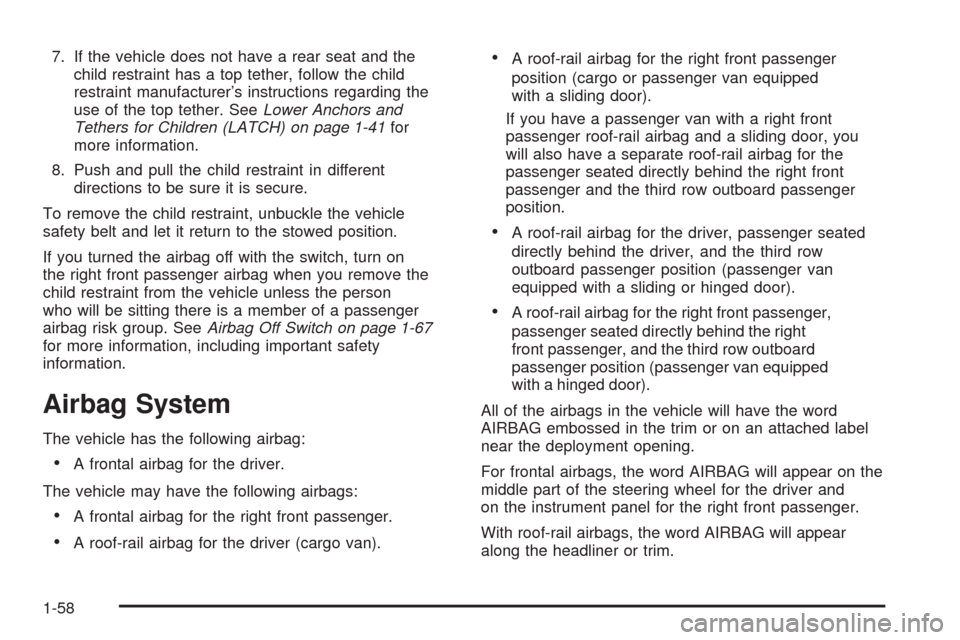
7. If the vehicle does not have a rear seat and the
child restraint has a top tether, follow the child
restraint manufacturer’s instructions regarding the
use of the top tether. SeeLower Anchors and
Tethers for Children (LATCH) on page 1-41for
more information.
8. Push and pull the child restraint in different
directions to be sure it is secure.
To remove the child restraint, unbuckle the vehicle
safety belt and let it return to the stowed position.
If you turned the airbag off with the switch, turn on
the right front passenger airbag when you remove the
child restraint from the vehicle unless the person
who will be sitting there is a member of a passenger
airbag risk group. SeeAirbag Off Switch on page 1-67
for more information, including important safety
information.
Airbag System
The vehicle has the following airbag:
•A frontal airbag for the driver.
The vehicle may have the following airbags:
•A frontal airbag for the right front passenger.
•A roof-rail airbag for the driver (cargo van).
•A roof-rail airbag for the right front passenger
position (cargo or passenger van equipped
with a sliding door).
If you have a passenger van with a right front
passenger roof-rail airbag and a sliding door, you
will also have a separate roof-rail airbag for the
passenger seated directly behind the right front
passenger and the third row outboard passenger
position.
•A roof-rail airbag for the driver, passenger seated
directly behind the driver, and the third row
outboard passenger position (passenger van
equipped with a sliding or hinged door).
•A roof-rail airbag for the right front passenger,
passenger seated directly behind the right
front passenger, and the third row outboard
passenger position (passenger van equipped
with a hinged door).
All of the airbags in the vehicle will have the word
AIRBAG embossed in the trim or on an attached label
near the deployment opening.
For frontal airbags, the word AIRBAG will appear on the
middle part of the steering wheel for the driver and
on the instrument panel for the right front passenger.
With roof-rail airbags, the word AIRBAG will appear
along the headliner or trim.
1-58
Page 63 of 408
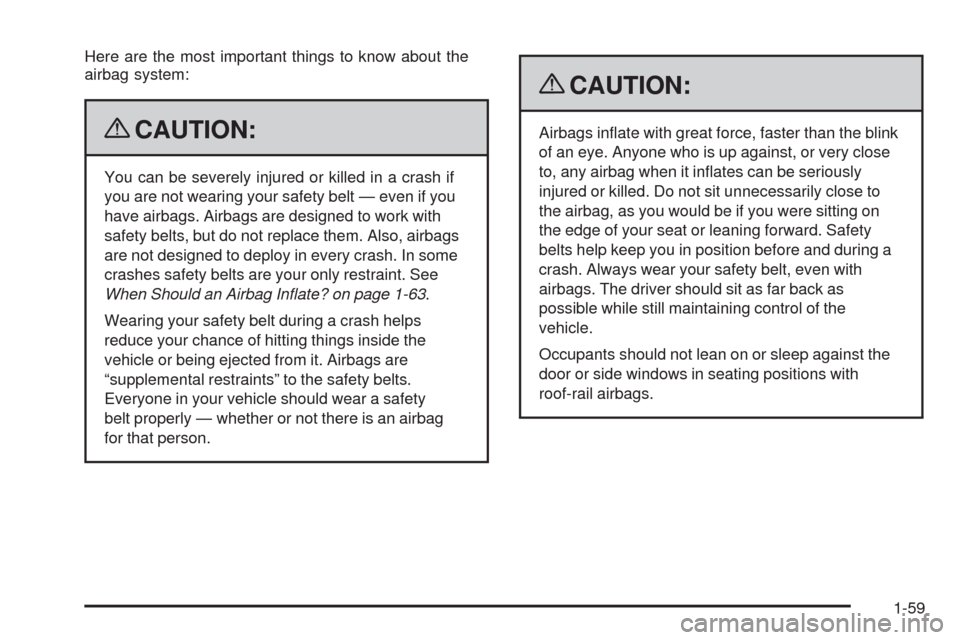
Here are the most important things to know about the
airbag system:
{CAUTION:
You can be severely injured or killed in a crash if
you are not wearing your safety belt — even if you
have airbags. Airbags are designed to work with
safety belts, but do not replace them. Also, airbags
are not designed to deploy in every crash. In some
crashes safety belts are your only restraint. See
When Should an Airbag Inflate? on page 1-63.
Wearing your safety belt during a crash helps
reduce your chance of hitting things inside the
vehicle or being ejected from it. Airbags are
“supplemental restraints” to the safety belts.
Everyone in your vehicle should wear a safety
belt properly — whether or not there is an airbag
for that person.
{CAUTION:
Airbags inflate with great force, faster than the blink
of an eye. Anyone who is up against, or very close
to, any airbag when it inflates can be seriously
injured or killed. Do not sit unnecessarily close to
the airbag, as you would be if you were sitting on
the edge of your seat or leaning forward. Safety
belts help keep you in position before and during a
crash. Always wear your safety belt, even with
airbags. The driver should sit as far back as
possible while still maintaining control of the
vehicle.
Occupants should not lean on or sleep against the
door or side windows in seating positions with
roof-rail airbags.
1-59
Page 65 of 408
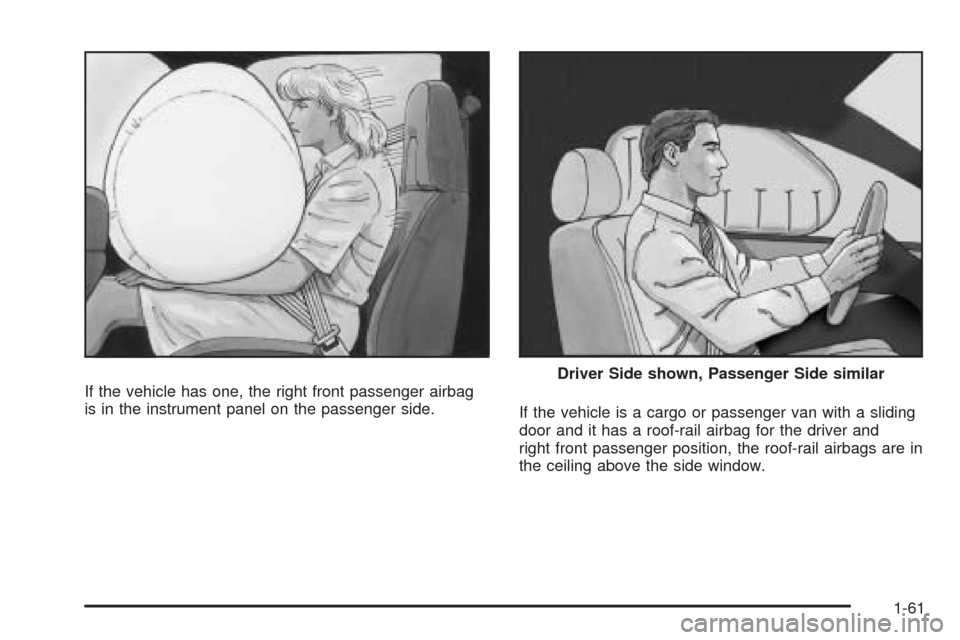
If the vehicle has one, the right front passenger airbag
is in the instrument panel on the passenger side.
If the vehicle is a cargo or passenger van with a sliding
door and it has a roof-rail airbag for the driver and
right front passenger position, the roof-rail airbags are in
the ceiling above the side window.Driver Side shown, Passenger Side similar
1-61
Page 66 of 408
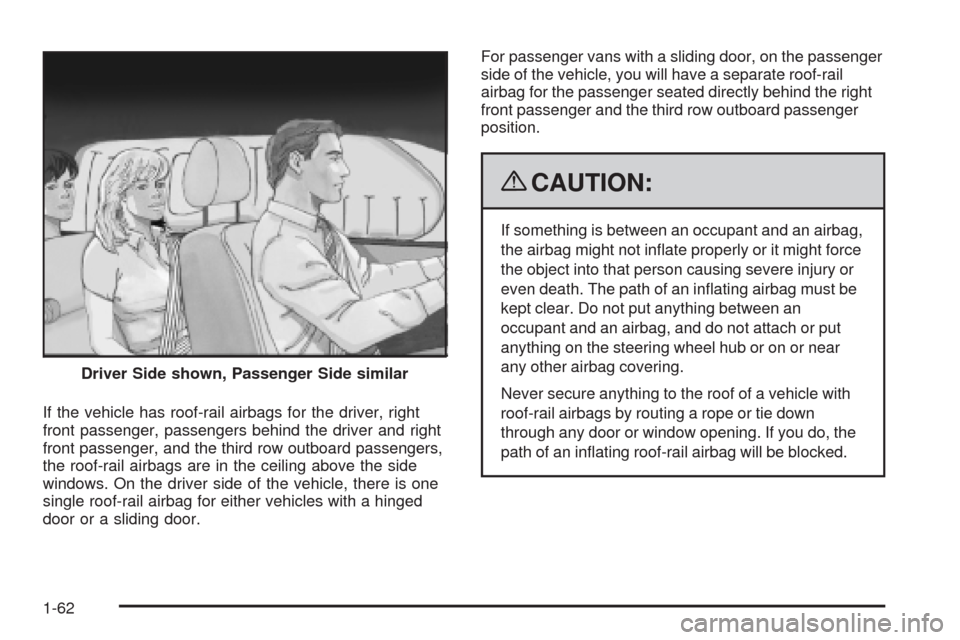
If the vehicle has roof-rail airbags for the driver, right
front passenger, passengers behind the driver and right
front passenger, and the third row outboard passengers,
the roof-rail airbags are in the ceiling above the side
windows. On the driver side of the vehicle, there is one
single roof-rail airbag for either vehicles with a hinged
door or a sliding door.For passenger vans with a sliding door, on the passenger
side of the vehicle, you will have a separate roof-rail
airbag for the passenger seated directly behind the right
front passenger and the third row outboard passenger
position.
{CAUTION:
If something is between an occupant and an airbag,
the airbag might not inflate properly or it might force
the object into that person causing severe injury or
even death. The path of an inflating airbag must be
kept clear. Do not put anything between an
occupant and an airbag, and do not attach or put
anything on the steering wheel hub or on or near
any other airbag covering.
Never secure anything to the roof of a vehicle with
roof-rail airbags by routing a rope or tie down
through any door or window opening. If you do, the
path of an inflating roof-rail airbag will be blocked. Driver Side shown, Passenger Side similar
1-62
Page 68 of 408

In addition, the vehicle may have dual-stage frontal
airbags. Dual-stage airbags adjust the restraint
according to crash severity. The vehicle has electronic
frontal sensors, which help the sensing system
distinguish between a moderate frontal impact and a
more severe frontal impact. For moderate frontal
impacts, dual-stage airbags inflate at a level less than
full deployment. For more severe frontal impacts,
full deployment occurs.
The vehicle may or may not have roof-rail airbags.
SeeAirbag System on page 1-58. Roof-rail airbags are
intended to inflate in moderate to severe side crashes.
In addition, these roof-rail airbags are intended to inflate
during a rollover. Roof-rail airbags will inflate if the
crash severity is above the system’s designed threshold
level. The threshold level can vary with specific
vehicle design.
Roof-rail airbags are not intended to inflate in frontal
impacts, near-frontal impacts, or rear impacts. All roof-rail
airbags will deploy when either side of the vehicle is
struck.In any particular crash, no one can say whether an
airbag should have inflated simply because of the
damage to a vehicle or because of what the repair costs
were. For frontal airbags, inflation is determined by what
the vehicle hits, the angle of the impact, and how quickly
the vehicle slows down. For roof-rail airbags, deployment
is determined by the location and severity of the side
impact.
What Makes an Airbag In�ate?
In a deployment event, the sensing system sends an
electrical signal triggering a release of gas from the
inflator. Gas from the inflator fills the airbag causing the
bag to break out of the cover and deploy. The inflator, the
airbag, and related hardware are all part of the airbag
module.
Frontal airbag modules are located inside the steering
wheel and instrument panel. For vehicles with roof-rail
airbags, there are airbag modules in the ceiling of the
vehicle, near the side windows for the first, second, and
third rows (if equipped). SeeWhere Are the Airbags? on
page 1-60for more information.
1-64
Page 69 of 408
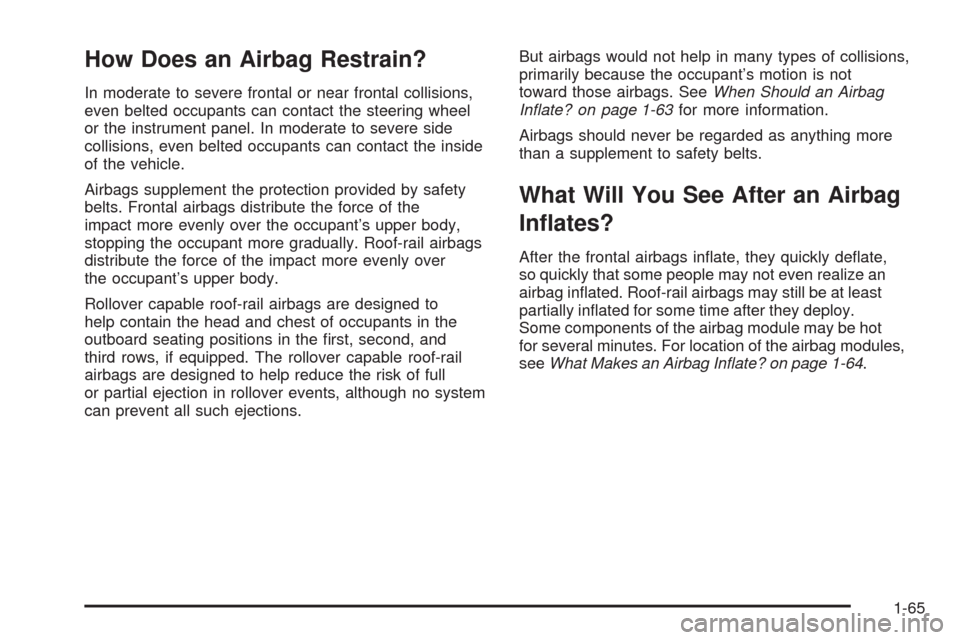
How Does an Airbag Restrain?
In moderate to severe frontal or near frontal collisions,
even belted occupants can contact the steering wheel
or the instrument panel. In moderate to severe side
collisions, even belted occupants can contact the inside
of the vehicle.
Airbags supplement the protection provided by safety
belts. Frontal airbags distribute the force of the
impact more evenly over the occupant’s upper body,
stopping the occupant more gradually. Roof-rail airbags
distribute the force of the impact more evenly over
the occupant’s upper body.
Rollover capable roof-rail airbags are designed to
help contain the head and chest of occupants in the
outboard seating positions in the first, second, and
third rows, if equipped. The rollover capable roof-rail
airbags are designed to help reduce the risk of full
or partial ejection in rollover events, although no system
can prevent all such ejections.But airbags would not help in many types of collisions,
primarily because the occupant’s motion is not
toward those airbags. SeeWhen Should an Airbag
Inflate? on page 1-63for more information.
Airbags should never be regarded as anything more
than a supplement to safety belts.
What Will You See After an Airbag
In�ates?
After the frontal airbags inflate, they quickly deflate,
so quickly that some people may not even realize an
airbag inflated. Roof-rail airbags may still be at least
partially inflated for some time after they deploy.
Some components of the airbag module may be hot
for several minutes. For location of the airbag modules,
seeWhat Makes an Airbag Inflate? on page 1-64.
1-65
Page 74 of 408

Passenger Sensing System
If the instrument panel has one of the indicators
pictured in the following illustrations, the vehicle has a
passenger sensing system unless there is an airbag
off switch located on the instrument panel. If there
is an airbag off switch, the vehicle does not have
a passenger sensing system. SeeAirbag Off Switch
on page 1-67for more information.
The passenger airbag status indicator will be visible on
the instrument panel when the vehicle is started.
The words ON and OFF, or the symbol for on and off,
will be visible during the system check. When the
system check is complete, either the word ON or the
word OFF, or the symbol for on or the symbol for off, will
be visible. SeePassenger Airbag Status Indicator on
page 3-29.The passenger sensing system will turn off the right
front passenger frontal airbag under certain conditions.
The driver airbag and roof-rail airbags, if equipped,
are not part of the passenger sensing system.
The passenger sensing system works with sensors that
are part of the right front passenger seat. The sensors
are designed to detect the presence of a properly-seated
occupant and determine if the right front passenger
frontal airbag should be enabled (may inflate) or not.
Accident statistics show that children are safer if
they are restrained in the rear rather than the front seat.
We recommend that children be secured in a rear
seat, including: an infant or a child riding in a rear-facing
child restraint; a child riding in a forward-facing child
seat; an older child riding in a booster seat; and children,
who are large enough, using safety belts.
A label on the sun visor says, “Never put a rear-facing
child seat in the front.” This is because the risk to
the rear-facing child is so great, if the airbag deploys. United States
Canada
1-70
Page 80 of 408

Servicing Your Airbag-Equipped
Vehicle
Airbags affect how the vehicle should be serviced.
There are parts of the airbag system in several places
around the vehicle. Your dealer/retailer and the
service manual have information about servicing the
vehicle and the airbag system. To purchase a service
manual, seeService Publications Ordering Information
on page 7-16.
{CAUTION:
For up to 10 seconds after the ignition is turned off
and the battery is disconnected, an airbag can still
inflate during improper service. You can be injured
if you are close to an airbag when it inflates. Avoid
yellow connectors. They are probably part of the
airbag system. Be sure to follow proper service
procedures, and make sure the person performing
work for you is qualified to do so.
Adding Equipment to Your
Airbag-Equipped Vehicle
Q:Is there anything I might add to or change
about the vehicle that could keep the airbags
from working properly?
A:Yes. If you add things that change the vehicle’s
frame, bumper system, height, front end or side
sheet metal, they may keep the airbag system from
working properly. Changing or moving any parts
of the front seats, safety belts, the airbag sensing
and diagnostic module, steering wheel, instrument
panel, roof-rail airbag modules, ceiling headliner
or pillar garnish trim, front sensors, or airbag wiring
can affect the operation of the airbag system.
1-76